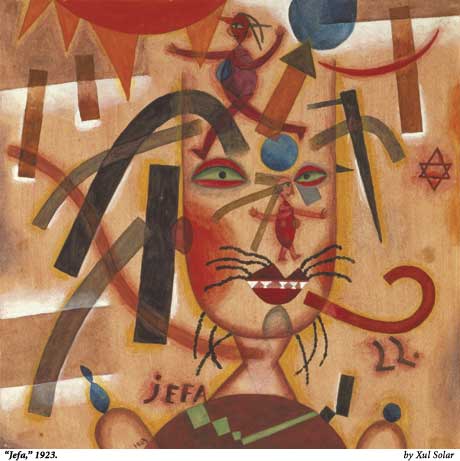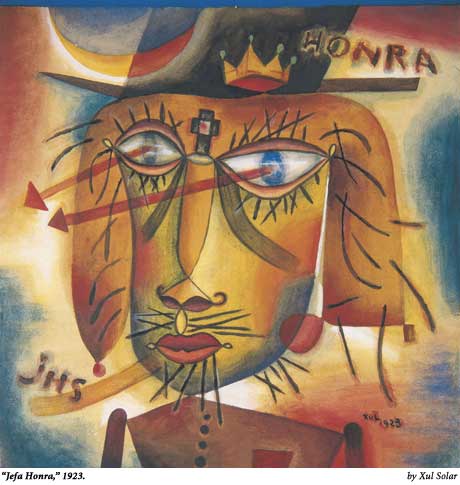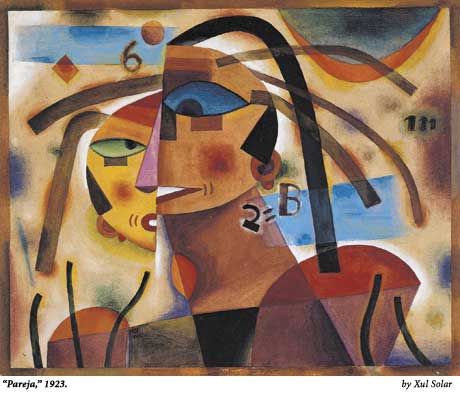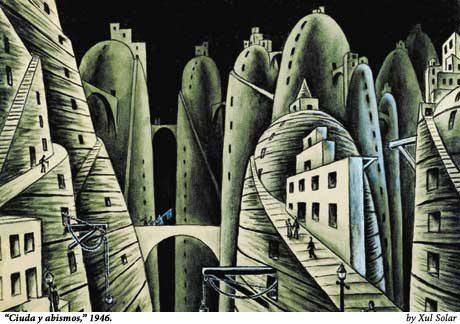Examine Everything
Houston’s Museum of Fine Arts is the only U.S. stop for “Visions and Revelations,” a dazzling retrospective of the work of the late Argentine avant-garde artist Xul Solar (1887-1963). It’s the first comprehensive showing of Xul Solar’s work in the United States and a big step forward in the museum’s plan to be an international leader in Latin American and Latino art. The artist, whose given name was Alejandro Schulz Solari, changed it to Xul (pronounced shool) Solar as he progressed in his studies of the occult. Tarot, astrology, and other elements of spiritual quest such as ladders and walls figure prominently throughout his work, along with frequent references to the Western Hemisphere as a New World. “Xamine todo!” (Examine everything!), he wrote on one of his last paintings.
The exhibition will be at the Museum of Fine Arts through April 16 and then will go to the Rufino Tamayo Museum in Mexico City from May 18 through August 20. Recently the Observer spoke to Dr. Mari Carmen Ramírez, the museum’s curator of Latin American art. The following is an excerpt of that conversation:
Texas Observer: I had been interested in seeing this exhibit ever since I saw reports about it last summer from Buenos Aires and noticed that it was coming to Houston. How did the Museum of Fine Arts become the U.S. host?
Dr. Ramírez: Well, Xul Solar has been from the very beginning one of the artists we targeted as a priority to be represented in the collection of this museum, as well as to do exhibitions of his work. He is a major figure of the Latin American avant garde who is known in specialized circles in the United States, but his work is not really known by U.S. audiences. The focus of what we are trying to do here at the Museum of Fine Arts is precisely to introduce to U.S. audiences major figures of the Latin American avant garde that have not received the kind of exposure that they should. Xul Solar was a perfect figure for that. He is a unique artist and his significance really transcends Latin America.
TO: Why is that? What’s his involvement in international movements?
Dr. Ramírez: He was not so much involved in international movements. He lived in Europe between 1912 and 1924 and absorbed the influences of course of all the major movements of the time beginning with Cubism, German Expressionism, and Dadaism. So he was really imbued with all the latest currents, but managed to make out of them something that was very much his own. It was a utopian vision of society and a utopian vision of the role of art in that society.
TO: I’ve seen references to Xul as being Klee-like. Is that as good a way as any to communicate what he was like or what people can expect to see?
Dr. Ramírez: When you see Xul’s work the most likely point of reference is Paul Klee because they both worked with watercolor, they both worked with very fanciful figures. They also worked with this very flat base that is very transparent and at the same time creates a very magical state. They also incorporate Cubism and of course German Expressionism. Klee becomes a point of reference to understand Xul, but that’s because he is the only other figure people can think of to relate to his work. There is kind of a formal relationship between them but it’s very superficial. What Klee was trying to do and what Xul was trying to do ultimately were two very different things.
It goes back to the idea that Xul was very much involved with esoteric beliefs. He was very much involved with magic. He was very much involved with linguistics. He was involved with all these very complex systems of thought. His watercolors, these fanciful revisions that he makes, are not just for the sake of fancy, but to illustrate these visions that he had of religious and philosophical systems that he was involved with.
TO: In Latin American writing in the first half of the last century you find poets talking about creating their own universe—or “the poet is a small god” and what have you. Is what Xul did related to all that?
Dr. Ramírez: It has nothing to do with the creation of this kind of tropical exotic exuberant universe with which Latin American art has frequently been related. It’s a far more personal journey undertaken by Xul Solar. There are a number of works—portraits of people like “Jefa,” which we have been using for the promotion of the exhibition. All of those portraits of women or men, they are of people that were initiated into these particular magic cults. They all share the same characteristics. The features of the faces, the motifs are taken from different artistic sources. For instance, many times the eyes refer to Egyptian art. Some of the figures have whiskers, which refer you to pre-Columbian art. There are all sorts of motifs of serpents or the moon or the sun. There is a kind of secret language or code in each one of these works that is part of Xul’s very personal world. But at the same time the work is extremely accessible. You don’t really have to know all of that secret language to really understand the work or relate to it. That is ultimately what makes him such a great artist.
TO: One of your first goals at the museum was to acquire his work for the collection. Why is that? What is his importance within Latin American contemporary art?
Dr. Ramírez: He is one of the major exponents of the avant garde in Latin America and he is a unique figure. There are no other people who followed him. He did not leave a school. He is just a unique artist. Therefore his work, the good examples of his work, is very hard to come by. You can find minor examples here and there, small watercolors that are available in the secondary market, but it’s very hard to really acquire what we would consider museum-quality pieces. We were very lucky because we established contact early on with the Fundación Pan Klub, which is the foundation that runs the estate of the artist and they also run the [Xul Solar] museum in Buenos Aires. They understood the importance of a museum like the Museum of Fine Arts in Houston having Xul Solar as part of their collection and went as far as making available two very important works that are now part of our collection.

TO: I was interested to see the pre-Columbian images. But he didn’t have any first-hand knowledge of Mexico—that was more from his imagination, wasn’t it?
Dr. Ramírez: He studied Mexican pre-Columbian art at the British Museum during his days in London. There are a number of books in his library that document Mexican art, pre-Columbian art. He may not have traveled to Mexico, but he was interested in and directly experienced the art at the British Museum.

TO: There was mention that he sold very little during his career, I assume by choice. Is that correct?
Dr. Ramírez: He was not the kind of artist we know today that is actively selling in galleries and has gallery dealers and shows and exhibitions. He was not that kind of artist at all, actually. It’s also important to bear in mind that he was not just a painter or a visual artist. His watercolors—even though he produced so many—are just one aspect of what he did. He was really a more complicated kind of intellectual. He wrote poetry. He also wrote very innovative prose, much like the tradition of James Joyce. He also was involved with the creation of two languages. He wanted to come up with a way, with a system so that people all over the world could communicate with each other without having to resort to their native languages. He was very much involved in linguistics and word creation.

TO: His relationship with Borges—does that translate into his artistic work?
Dr. Ramírez: He and Borges were kind of in their own universe. They were extremely close friends. They lived close to each other and would have breakfast, then discuss things for hours, then have lunch, and then go on with the discussion. Borges considered him to be one of the greatest intellectuals he had ever met. Early on in the 1920s they were part of an avant-garde group, the first one established in Buenos Aires that brought together artists and writers. That [avant-garde] movement was trying to bring about a renovation of the artistic milieu in Argentina. They were really trying to promote a new way of making art. They were also arguing for a new form of Argentinean art that would not be folkloric or realistic, that would incorporate all the innovative languages like Cubism and other avant-garde movements.
TO: At the end, when he has a painting that is called “Xamine Todo,” it seemed a very eloquent title. Was that a summation of everything he was about?
Dr. Ramírez: I don’t know that you can really make it into a summation. It’s hard to read in his work a specific meaning. You have to take it as more a part of all these very general quests that he was trying to portray. I think the whole point was that this was an ongoing quest, an ongoing journey. It was his role to keep opening up new doors or new levels of understanding. Ultimately it was not something that could be achieved at any one point—that’s why it was a utopia in the true sense of the word, something that doesn’t exist but you really strive for.
TO: The exhibit has also been in Brazil. Have you had feedback?
Dr. Ramírez: I was actually in Brazil when it opened and there was a lot of publicity surrounding the show. The thing about these kinds of artists in Latin America is that they are frequently known—if they are known outside of their countries—in the U.S. or Europe, and in Latin America itself very few people have seen their work. We have very serious problems in Latin America in terms of the circulation of art among the different countries. To have an exhibit like Xul Solar travel to Sao Paulo is a first for many people. They have not seen it. It’s a first for Brazil to see this kind of artist, to see someone that worked in a very different language from what was happening in Brazil at the time but at the same time was related to all of these notions of the avant garde.

TO: The program that you have started—the creation of this endowment—what are your hopes, what are your main goals for the museum in Latin American and Latino art?
Dr. Ramírez: In 2001 we established a department of Latin American art and a research center called the International Center for the Arts of the Americas. I think this is a very unique initiative, there is nothing like it anywhere else. We plan to do research-based exhibitions like this one, which is based on a very serious investigation of Xul Solar’s work. We want to do these kinds of exhibitions that open up new avenues of knowledge and introduce these artists for the first time to U.S. audiences. At the same time we are doing a very broad research project, we are creating a digital archive for writings by Latin American artists, and we are also working with the education department to educate the public. It is a very ambitious initiative, but the museum wants to position itself as the leader in Latin American and Latino art in the United States and probably outside the United States too. We’ve been at it for five years and we have had an incredible amount of success, so we hope it continues.
TO: I know there’s lots we could talk about. Is there something you would like to express about the exhibit and about this artist?
Dr. Ramírez: I think it’s very important to see his art and understand it because it really breaks down the stereotypes that people have about Latin American art. Here you have the case of an artist who absorbed the language of the avant garde but makes it his own and reaches beyond his country to create a truly universal kind of language that people all over the world can relate to. It’s also very complex art, as I said before. It mixes influences from many different world cultures. It mixes languages and mixes different religious systems and systems of understanding the world. I think for many people it will be a discovery, that a Latin American country could produce an artist as sophisticated and as innovative and radical as Xul Solar. Xul is really Xul—he doesn’t copy anyone. He was very much at the forefront of art in his time.
Soll Sussman lives in Austin. He frequently writes about culture in the Americas.


